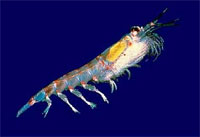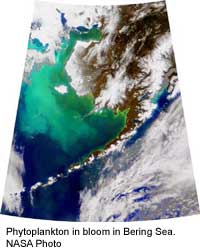|

 Krill have a hard exoskeleton, many legs (used for swimming and
gathering food), and a segmented body. Females produce almost 1,000
eggs each summer; the eggs are laid at the surface, but fall to
great depths. The hatchlings swim back to the surface to feed. Like
all crustaceans, krill molt their exoskeleton as they grow. Krill have a hard exoskeleton, many legs (used for swimming and
gathering food), and a segmented body. Females produce almost 1,000
eggs each summer; the eggs are laid at the surface, but fall to
great depths. The hatchlings swim back to the surface to feed. Like
all crustaceans, krill molt their exoskeleton as they grow.

Species: There are about 85 species of krill, ranging in size from less than
0.5 inch (1 cm) up to 5.5 inches (14 cm) long. The dominant krill
in the southern polar oceans is the Antarctic krill, which is up
to 2.3 inches (6 cm) long and weighs about 0.035 ounces (1 g). Antarctic
krill have a life span of about 5 to 10 years. Antarctic Krill is
considered to be a keystone species, an organism upon which very
many Antarctic predators depend.
 Krill eat phytoplankton, single-celled plants that float in the
seas near the surface. Krill spend their days in the dark depths
of the ocean (about 320 feet = 100 m deep), safe from their major
predators (like whales and sea birds). They swim to the surface
each night to eat, but can fast for up to 200 days, shrinking in
size during that time. Krill eat phytoplankton, single-celled plants that float in the
seas near the surface. Krill spend their days in the dark depths
of the ocean (about 320 feet = 100 m deep), safe from their major
predators (like whales and sea birds). They swim to the surface
each night to eat, but can fast for up to 200 days, shrinking in
size during that time.
All text is available under the terms
of the GNU Free Documentation License
|